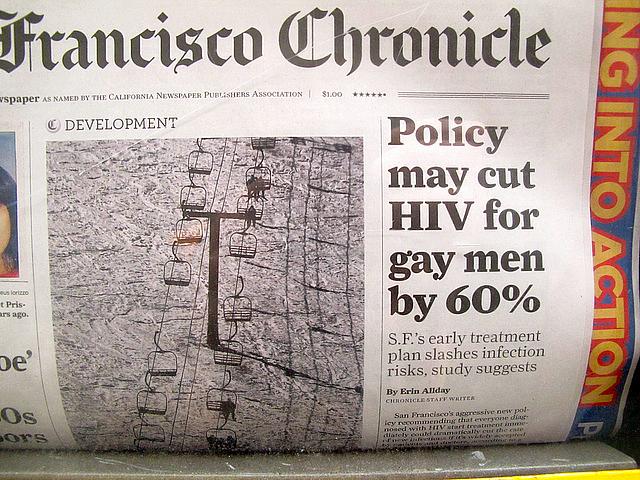Can San Francisco’s HIV prevention ‘miracle’ be replicated throughout the state?

Recently, The New York Times lauded San Francisco’s remarkable turnaround with HIV. The City by the Bay saw a nearly 19 percent drop in new infections between 2013 and 2014. Since then, San Francisco has doubled down by dedicating an additional million dollars to its two-pronged strategy of “treatment as prevention” (getting those with HIV on treatment upon diagnosis, and reduce their viral load to a point where they can no longer pass HIV to others) and increasing access to pre-exposure prophylaxis or PrEP (the HIV prevention treatment in the form of a once-daily pill that’s 96 percent effective).
San Francisco is now on target to meet its goal of being “AIDS-free by 2030.” But that’s hardly the picture for other California cities. As federal funding for HIV prevention has remained relatively flat in the past five years, a greater portion of the prevention funding burden has fallen on states and local agencies, just as those budgets have been repeatedly slashed. While California continues to provide more funding than many states, statewide HIV funding faces ongoing budget cuts, and some of the hardest-hit cities are working with few resources.
In 2011, Fresno County’s number of new HIV cases spiked 73 percent over the county’s previous five-year average. For nearly a decade, the county has been struggling with an explosion of injection drug use. Injection drug users are at an especially high risk for getting HIV, but often have trouble accessing services that prevent HIV (such as mental health care, PrEP, and clean needles — despite California’s needle exchange law, studies show access remains limited).
Even in San Francisco, where municipal funding and private foundations have ponied up more dough for prevention efforts, health disparities continue: The city acknowledged it needs to do more to reach young men of color, who are disproportionately affected by HIV, and who are significantly less likely to receive or know about PrEP. When provided education, nearly 80 percent of this population say they would use PrEP if given access.
San Francisco’s success with early treatment and access to PrEP certainly seem to have made a dramatic impact. But are other factors at play? In recent years the city’s notoriously high rents and booming tech companies have driven low and middle income families out of the city. Could the city’s health care successes simply reflect a more affluent populace? Or, if the HIV drop is a result of a public policy push, is the city’s equation transferable to other locales and demographics?
Would the same investment make the same impact in Fresno? Immigrants make up 22 percent of the county population, many of whom are undocumented. Can efforts that work among white gay men in San Francisco also work for Fresno’s undocumented immigrants or injection drug users (who have high rates of homelessness and incarceration as well)?
Researchers now know treatment is one of the best forms of HIV prevention, so examining health outcomes — and disparities across race, gender, income, sexuality, immigrant status and method of transmission — is essential to understanding our state’s effort to become a post-HIV society.
Through a series of articles and a multimedia project, Plus magazine will explore the complex issues around HIV prevention efforts, funding, health outcomes and the financial cost of failure. With the education provided by the 2015 California Data Fellowship, I’ll look at health outcomes by examining data sets available through the California health portal, Kaiser’s California health information databases, and the CDC’s NCHHSTP Atlas.
In order to gain a broader look at prevention spending, I’ll review Kaiser Family Foundation’s 2013 “National HIV Prevention Inventory: The State of HIV Prevention Across the U.S.,” which shows California gets more funding for prevention than many states but that doesn’t translate to more dollars spent per person living with HIV. I’ll also connect with HIV service organizations, AIDS foundations, and city, county, and state public health departments to review spending and the effectiveness of various prevention strategies and campaigns.
Although data may drive this series, the heart of it revolves around personal stories. Plus magazine will elicit first-person stories from those most directly impacted by current prevention funding decisions, and use personal narratives about education, prevention, and treatment efforts that dovetail with the data.
We will travel to representative communities around the state to meet stakeholders face-to-face, learn about the unique difficulties impacting current and future HIV prevention efforts and discover what culturally competent HIV prevention efforts could look like. Finally we will share our findings with our readers and important stakeholders across multiple platforms.
[Photo by torbakhopper via Flickr.]
